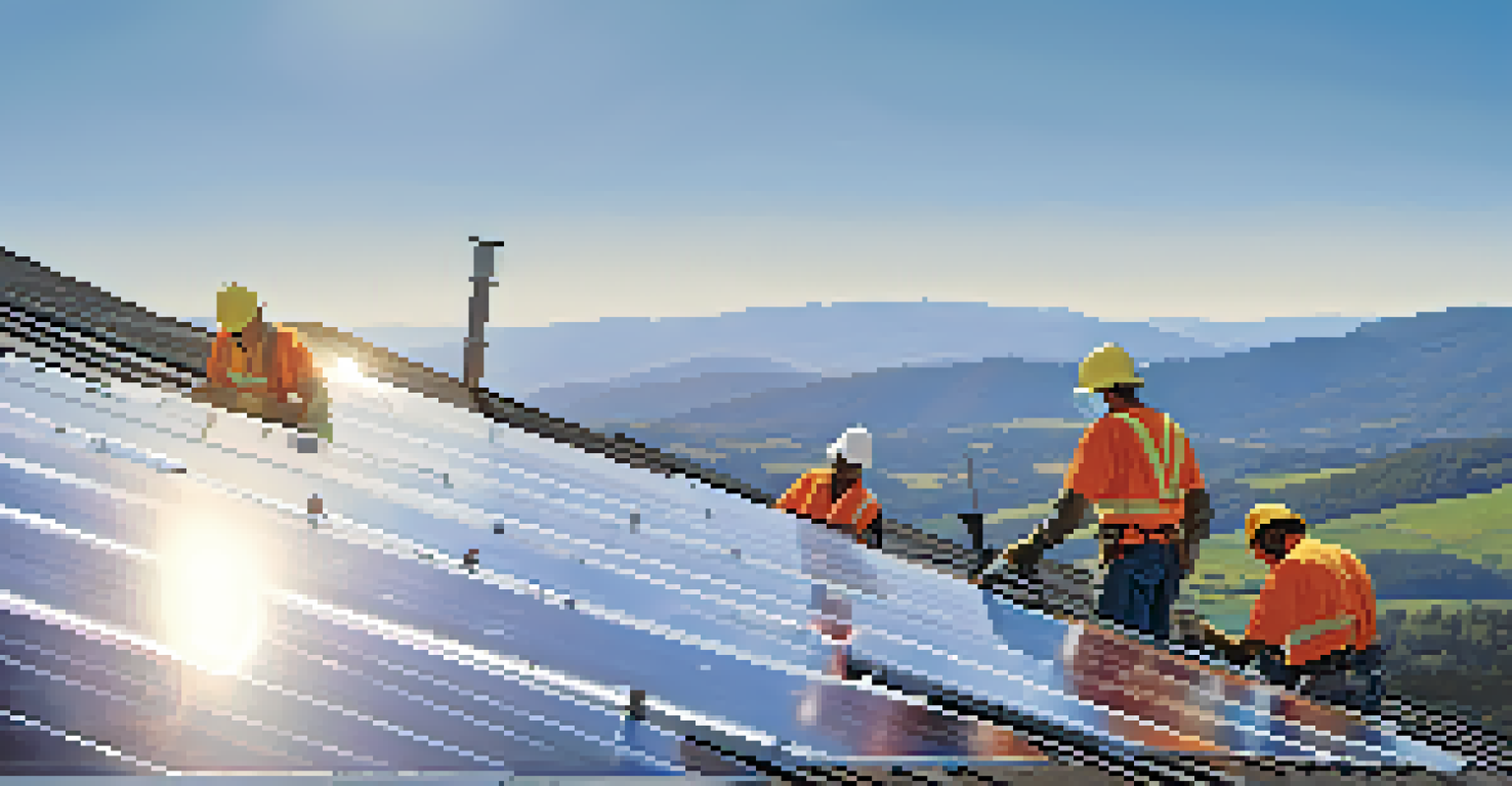Employing Solar Panels for Sustainable Energy Solutions

Understanding Solar Energy and Its Benefits
Solar energy is derived from the sun's rays, making it a renewable and abundant resource. This form of energy can be harnessed using solar panels, which convert sunlight into electricity, providing a cleaner alternative to fossil fuels. One of the key benefits of solar energy is its ability to reduce greenhouse gas emissions, contributing to a healthier planet.
The sun is the most powerful energy source on the planet, and it is free and abundant. We just need to harness it.
In addition to environmental benefits, solar energy can also lead to significant cost savings. Homeowners and businesses can lower their electricity bills by using solar panels, as they rely less on grid power. Over time, the initial investment in solar technology pays off, making it an economically sound choice.
Moreover, solar energy systems can increase property value. Homes equipped with solar panels often sell for more than those without, making them an attractive option for prospective buyers. This added value, along with the potential for energy independence, highlights why more people are turning to solar solutions.
How Solar Panels Work: A Simple Breakdown
At the heart of solar energy systems are solar panels, which are made up of photovoltaic (PV) cells. These cells capture sunlight and convert it into direct current (DC) electricity. An inverter then changes this DC electricity into alternating current (AC), which is the form of electricity used in homes and businesses.

In simple terms, you can think of solar panels as sponges soaking up sunlight. Just as a sponge holds water, solar panels hold energy from the sun and release it for use. This conversion process allows for a seamless flow of energy, making solar power an efficient choice.
Solar Energy Reduces Emissions
Harnessing solar energy decreases greenhouse gas emissions, promoting a healthier environment.
Additionally, solar panels can be installed on rooftops or in ground-mounted systems, depending on space and energy needs. This flexibility means that almost anyone can adopt solar technology, whether they have a spacious yard or live in an urban setting. It's an accessible solution for harnessing renewable energy.
Choosing the Right Solar Panels for Your Needs
When considering solar panels, it's crucial to evaluate your specific energy needs and budget. There are different types of solar panels available, including monocrystalline, polycrystalline, and thin-film panels. Each has its own efficiency ratings and costs, so understanding these differences can help you make an informed decision.
Solar energy is the energy of the future, and it will be the most important energy source in the world.
For instance, monocrystalline panels are known for their high efficiency and performance in limited space, making them a popular choice despite their higher price tag. On the other hand, polycrystalline panels are typically less expensive but may require more space for the same energy output. By assessing your situation, you can select the best option for your home or business.
It's also important to consider the warranty and lifespan of solar panels. Most panels come with warranties ranging from 25 to 30 years, providing peace of mind regarding their durability. Investing in reliable solar technology ensures that you enjoy the benefits of renewable energy for years to come.
The Role of Government Incentives in Solar Adoption
Government incentives play a significant role in promoting solar panel installations. Many countries offer tax credits, rebates, and grants to encourage homeowners and businesses to invest in solar energy. These financial incentives make the transition to solar power more affordable and appealing.
For example, in the United States, the Federal Investment Tax Credit (ITC) allows solar owners to deduct a substantial percentage of the installation costs from their federal taxes. This incentive can significantly reduce the upfront costs, making solar energy accessible to a broader audience.
Cost Savings with Solar Panels
Investing in solar panels can significantly lower electricity bills and increase property value.
Additionally, state and local programs often complement federal incentives with their own offerings. By staying informed about available programs, you can maximize your savings and make a more sustainable choice. This collaborative effort between governments and citizens fosters a greener future for everyone.
Solar Panel Installation: What to Expect
Installing solar panels is a straightforward process, but it requires careful planning. First, it's essential to conduct an energy audit to determine your energy consumption and needs. This helps in designing a solar system that meets your specific requirements.
Once you have a plan in place, the installation team will assess your property for optimal solar panel placement. Factors such as roof orientation, shading, and available space are considered to maximize energy production. This thorough evaluation ensures that your solar system operates efficiently.
After installation, the final step involves connecting the solar panels to your home's electrical system. This process typically takes one to three days, and once completed, you can start enjoying the benefits of solar energy. It's an exciting moment, as you transition to a more sustainable energy source.
Maintaining Your Solar Panels for Longevity
One of the great aspects of solar panels is their low maintenance requirements. Unlike traditional energy systems, solar panels have no moving parts, which significantly reduces the chances of wear and tear. However, some basic upkeep is still necessary to ensure optimal performance.
Regular cleaning is essential to keep your solar panels free from dirt, debris, and bird droppings. A simple wash with water and a soft brush can do wonders for maintaining efficiency. Depending on your location, you may need to clean your panels a few times a year to maximize energy output.
Government Incentives Boost Adoption
Financial incentives like tax credits make switching to solar energy more affordable for homeowners.
Additionally, monitoring your solar system's performance can help identify any issues early on. Many modern systems offer monitoring tools that allow you to track energy production and consumption. By staying proactive with maintenance, you can enjoy the long-term benefits of solar energy while ensuring your investment remains in top shape.
The Future of Solar Energy: Trends and Innovations
As technology continues to advance, the future of solar energy looks brighter than ever. Innovations such as solar shingles and floating solar farms are gaining traction, making solar solutions even more versatile and accessible. These developments are paving the way for widespread adoption of solar power.
For instance, solar shingles seamlessly blend with traditional roofing materials, providing an aesthetically pleasing option for homeowners. This integration allows individuals to harness solar energy without compromising the look of their homes. As these technologies evolve, more people will feel encouraged to make the switch.

Moreover, advancements in energy storage solutions, like batteries, are enhancing the reliability of solar energy systems. With improved storage capabilities, users can store excess energy for use during cloudy days or at night. This trend signifies a shift toward a more sustainable energy future, where solar power plays a central role.